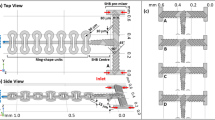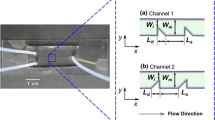Abstract
A novel micromixing strategy is presented, which exploits the axial diffusion of a continuous sequence of discrete samples in a microchannel expansion. Mixing of a continuous sequence in an electroosmotic flow through a sudden expansion region is first modeled assuming an ideal, square-wave injection. The effect of expansion geometry and injection frequency is investigated. To facilitate sequential injection on-chip, two new sequential sample injection schemes are developed and coupled with an expansion region. The first of these designs produces two sample pairs that flow out of separate channels into a common expansion region. This design results in high axial mixing rates but an inherent bias in the injector produces significant cross-stream concentration gradients in the output. These results indicate that the effectiveness of this micromixing strategy is critically dependant on the injection method. A second injector design effectively eliminates the effect of the injection bias using a symmetric microchannel configuration with three solution inlets. The resulting symmetrical injection micromixer produces a continuous uniform stream, 99% mixed, in only 2.3 mm.









Similar content being viewed by others
References
Alarie JP, Jacobson SC, Ramsey JM (2001) Electrophoretic injection bias in a microchip valving scheme. Electrophoresis 22:312–317
Bianchi F, Ferrigno R, Girault HH (2000) Finite element simulation of an electroosmotic-driven flow division at a T-junction of microscale dimensions. Anal Chem 72:1987–1993
Biddiss E, Erickson D, Li D (2004) Heterogeneous surface charge enhanced micromixing for electrokinetic flows. Anal Chem 76:3208–3213
Deshmukh AA, Liepmann D, Pisano AP (2001) Characterization of a micro-mixing, pumping, and valving system. In: Proceedings of the 11th international conference on solid-state sensors and actuators (Transducers 2001), Munich, Germany, June 2001, pp 779–782
Erickson D, Li D (2002) Influence of surface heterogeneity on electrokinetically driven microfluidic mixing. Langmuir 18:1883–1892
Erickson D, Sinton D, Li D (2003) Joule heating and heat transfer in poly(dimethylsiloxane) microfluidic systems. Lab Chip 3:141–149
Ermakov SV, Jacobson, SC, Ramsey JM (1998) Computer simulations of electrokinetic transport in microfabricated channel structures. Anal Chem 70:4494–4504
Ermakov SV, Jacobson SC, Ramsey JM (2000) Computer simulations of electrokinetic injection techniques in microfluidic devices. Anal Chem 7:3512–3517
Fujii T, Sando Y, Higashino K, Fugii Y (2003) A plug and play microfluidic device. Lab Chip 3:193–197
Jacobson SC, Culbertson CT, Daler JE, Ramsey JM (1998) Microchip structures for submillisecond electrophoresis. Anal Chem 70:3476–3480
Jeon NL, Dertinger KW, Chiu DT, Choi IS, Stroock AD, Whitesides GM (2000) Generation of solution and surface gradients using microfluidic systems. Langmuir 16:8311–8316
Johnson TJ, Ross D, Locascio LE (2002) Rapid microfluidic mixing. Anal Chem 74:45–51
Liu RH, Stremler MA, Sharp KV, Olsen MG, Santiago JG, Adrian RJ, Aref H, Beebe DJ (2000) Passive mixing in a three-dimensional serpentine microchannel. J MEMS 9:190–197
Oddy MH, Santiago JG, Mikkelsen JC (2001) Electrokinetic instability micromixing. Anal Chem 73:5822–5832
Patankar NA, Hu HH (1998) Numerical simulation of electroosmotic flow. Anal Chem 70:1870–1881
Santiago JG (2001) Electroosmotic flows in microchannels with finite inertial and pressure forces. Anal Chem 73:2353–2365
Sinton D, Ren L, Li D (2003a) A dynamic loading method for controlling on-chip microfluidic sample injection. J Colloid Interface Sci 266:448–456
Sinton D, Ren L, Xuan X, Li D (2003b) Effects of liquid conductivity differences on multi-component sample injection, pumping and stacking in microfluidic chips. Lab Chip 3:173–179
Stone HA, Stroock AD, Ajdari A (2004) Engineering flows in small devices: microfluidics towards a lab-on-a-chip. Annu Rev Fluid Mech 36:381–411
Stroock AD, Dertinger SKW, Ajdari A, Mezić I, Stone HA, Whitesides GM (2002) Chaotic mixer for microchannels. Science 295:647–651
Tang Z, Hong S, Djukic D, Modi V, West AC, Yardley J, Osgood RM (2002) Electrokinetic flow control for composition modulation in a microchannel. J Micromech Microeng 12:870–877
Acknowledgments
Financial support of this work by the Natural Sciences and Engineering Research Council (NSERC) of Canada, through research grants to D.S., is gratefully acknowledged. Financial support from the Advanced Systems Institute of British Columbia, through a research award, is also gratefully acknowledged.
Author information
Authors and Affiliations
Corresponding author
Rights and permissions
About this article
Cite this article
Coleman, J.T., Sinton, D. A sequential injection microfluidic mixing strategy. Microfluid Nanofluid 1, 319–327 (2005). https://doi.org/10.1007/s10404-005-0034-y
Received:
Accepted:
Published:
Issue Date:
DOI: https://doi.org/10.1007/s10404-005-0034-y




